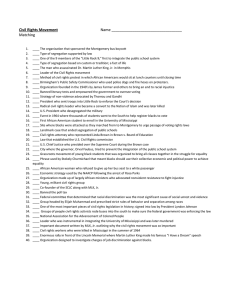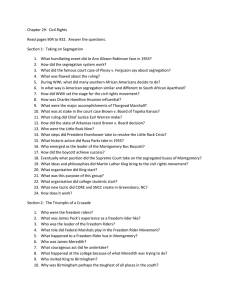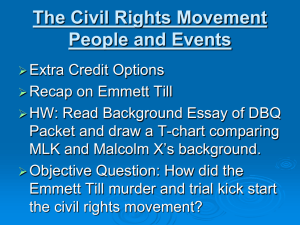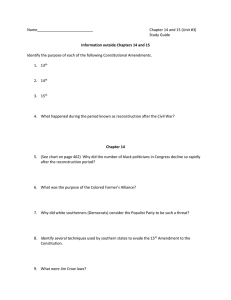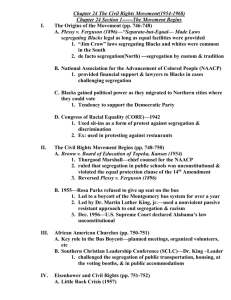The Civil Rights Movement
advertisement
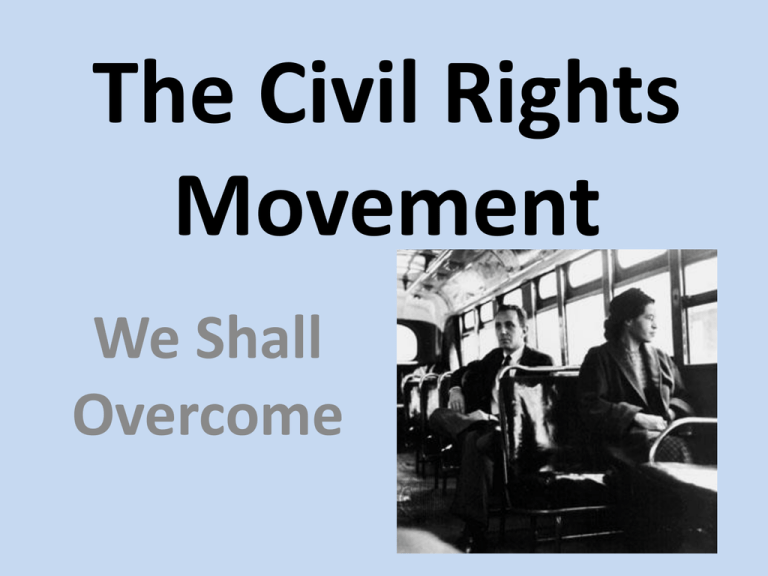
The Civil Rights Movement We Shall Overcome Civil War / Reconstruction • The Civil War freed over four million people who had been held in bondage. Slavery had been a part of American life for over two hundred years. • 13th Amendment – No More Slaves • Free • 14th Amendment – Who is a Citizen! • Citizens • 15th Amendment – Voting • Can Vote During reconstruction great strides were made in granting civil rights to former slaves. The rights of citizenship…. the right to vote… But when Reconstruction Ended – Jim Crow began and became the law of the land for blacks. Plessey vs. Ferguson • Homer Plessy – 7/8th White and 1/8th Black. When he sat in a rail car reserved for whites he was arrested. • He fought this arrest all the way to the Supreme Court Plessey v Ferguson In 1896 the Supreme Court decided that “separate but equal” was a fair way to deal with two races living side by side. The National Association for the Advancement of Colored People, or NAACP, an interracial membership organization, was founded in 1909, and is devoted to civil rights and racial justice. 1890’s – 1930’s • During this period Blacks followed both WEB DuBois and Booker T. Washington in their efforts to attain equality. • Neither plan made the progress one would hope. Many African American Men served in WWI . In Europe they were treated as Equals. Thought they would come home to the respect and dignity they had earned. WWI They were mistaken.. Race Riots • The summer of 1919 brought about numerous RIOTS around the country regarding race and especially jobs that Blacks had taken while WWI was going on. Tulsa Race Riot - 1921 • May 1921 – Race Riot broke out in the Greenwood District of Tulsa, OK. Greenwood was referred to as the “Black Wall Street” of it’s day. • Just as the oil boom had been good to White businesses in Tulsa – Blacks too had benefitted. • Whites started a and burned out the entire district. • Destroying all the wealth and growth Blacks had made in Tulsa. • This Riot was hidden (covered up) for many years – and it left a deep division in Tulsa of Blacks and Whites. Tulsa Race Riot KKK The KKK was it’s strongest yet in the 1920’s • Even boldly Marching the streets of Washington DC • Lynchings • An outside the law execution. • While these may not have occurred everyday, there was always the threat of one. The 1920s were followed by the depression years of the 1930s and just keeping food on the table was the concern of most people. The 30’s Jim Crow Laws Segregation was the law of the land in the South World War II took the United States out of the depression and lots of African American men and women into the military service. WWII These young men and women thought that FINALLY they would come home to respect and gratitude for their service. Again they were wrong, but this time they were ready to fight segregation and discrimination head on, where ever they encountered it. Executive Order - 9981 • In Executive Order # 9981 President Truman ordered the equal treatment of all in the military • When asked if he was desegregating – He responding strongly YES! • While Truman hoped this would be a major step in desegregation of the nation… it was just the beginning of a long hard fought battle. Brown v Board of Education of Topeka Kansas The Brown children had to walk through dangerous areas to get to the “colored” school. Their father sued to end school segregation. Segregation of public schools was legally banished in 1954 The Supreme Court decision did not mean that things were going to be easy for those first students who integrated white schools. Even with the court ruling, it takes President Eisenhower sending federal troops to Little Rock to force school integration there. Oklahoman’s Fights for Civil Rights • Two Major Court • McLaurin vs. Cases helped in Oklahoma State desegregating Board of Regents Higher Education before Brown V. • Sipuel vs. University of Oklahoma Board Board ever of Regents occurred. Sipuel vs. University of Oklahoma Regents • Ada Lois Sipuel (female) – applied to the University of Ok Law School in 1946. • Denied based on Race • Sued all the way to Supreme Court – Ruled that the state must provide equal instruction. • Oklahoma creates the Langston University Law School on the grounds of the State Capitol. • Additional Lawsuits to prove that the new Law School was not Equal. • June 18, 1949 – Sipuel will be admitted – Students and professors welcomed her and helped her catch up on missed time. The University did not welcome her. McLaurin vs. Oklahoma State Regents • George McLaurin – Applied to OU to work on a Doctorate Degree in Education. • Was admitted but forced to use completely separate facilities - desk in hall, special section in library, special table roped off in the Cafeteria, not allowed to use facilities that other students could. • Sued and Supreme Court ruled that a University could not provide separate treatment solely based on Race. • End of Separate but Equal in Graduate and Professional Education. Rosa Parks – Montgomery Bus Boycott In December of 1955 Rosa Parks refuses to give up her seat on the bus to a white man. The Montgomery Bus Boycott begins. The boycott lasts for more than a year, and the black citizens of Montgomery finally win, when the Supreme Court rules against segregation on public transportation. • The Oklahoma City Sitin Movement was led by NAACP Youth Council leader Clara Luper, a local high school teacher, and young local students. • The group quickly desegregated the Katz Drug Store lunch counters. • It took several more years, but she and the students, using the tactic, integrated all of Oklahoma City's eating establishments. Sit Ins – Katz Drug Store This triggers many similar nonviolent protests throughout the South. This form of protest becomes effective in integrating swimming pools, theaters, libraries and other southern public facilities. Freedom Riders One of the first two groups of "freedom riders," as they are called, encounters its first problem two weeks later, when a mob in Alabama sets the riders' bus on fire. 1963 – March on Washington Around 200,000 people joined Martin Luther King Jr. and other Civil Rights Leaders in Washington D.C. to protest for Equality. It is here that MLK gives the famous “I Have a Dream” Speech Birmingham Church Bombing • 16th Street Baptist Church – September 15, 1963 – Bomb explodes during Sunday School – killing four young girls. • This is the same church that was used during the Children’s March. • An Act of Terror th 24 Amendment - 1964 The 24th Amendment abolishes the poll tax, which originally had been instituted in 11 southern states after Reconstruction to make it difficult for poor blacks to vote. Civil Rights Act - 1964 President Johnson signs the Civil Rights Act of 1964. The most sweeping civil rights legislation since Reconstruction. The Civil Rights Act prohibits discrimination of all kinds based on race, color, religion, or national origin. The law also provides the federal government with the powers to enforce desegregation. Voting Rights Act of 1965 Congress passes the Voting Rights Act of 1965, making it easier for Southern blacks to register to vote. Literacy tests and other such requirements that were used to restrict black voting are made illegal. Selma • March 1965 – Tensions were very high in Selma – 82 year old male protestor had been beaten by a state trooper. • Trooper wasn’t done though – He follwed the older mans son into Café were he was trying to help his father and the trooper shot Jimmy Lee Jackson in the stomach (he died 7 days later) Montgomery • Protestors decide it is time to head to the capitol to force the issue with the Governor of Alabama. Blacks begin a march to Montgomery in support of voting rights but are stopped at the Pettus Bridge by a police blockade. Fifty marchers are hospitalized after police use tear gas, whips, and clubs against them. The incident is dubbed "Bloody Sunday" by the media. Selma to Montgomery • Two days later – March 9 will become known as “Turnaround Tuesday” – King led the marchers across the bridge and once again they faced state troopers – so rather than another assault they turned around. • Thanks to Media – This would be like no other Civil Rights Incident. • People began pouring into Selma from all over the Country (whites and blacks). • Six days later 4,000 marchers would leave from Selma to Montgomery – by they time they arrived 25,000 people were with them. MLK - Assasination April 4, 1968 Martin Luther King, at age 39, is shot as he stands on the balcony outside his hotel room. Escaped convict and committed racist James Earl Ray is convicted of the crime. Split in the Movement • On “Turn Around Tuesday” in Selma – When met with another round of potential violence, MLK asked the marchers to kneel in prayer together and then turned and walked away. • To many young black males this was a sign of weakness (gesture of defeat). Some began to fall away from the Non-Violence movement and became a part of a more militant group. Malcolm X Malcolm X will be one of the most charismatic leaders of the more militant group. He said that some individuals were willing to claim racial justice “by any means necessary.” • Malcolm X was originally Malcolm Little. • He went to prison for burglary and while in prison became a follower of Elijah Muhammad (Leader of the Lost-Found Nation of Islam 0r Black Muslims) Malcolm X • Malcolm Little would reject his “slave name” and become Malcolm X. • When released from prison he electrified many in the black community – giving them a sense of pride, purpose and potential. • Move away from Non-Violence to Militant Action – Advocating for the Total Separation of Blacks and Whites (whom he called a race of DEVILS) • While on pilgrimage to Mecca in 1964 – Malcolm X broke with the Black Musslims and found the Organization of Afro-American Unity – changing his message to one of a socialist solution. Black Panthers - 1966 The militant Black Panthers are founded by Huey Newton and Bobby Seale. Young African Americans think the older protesters are too slow and these young people are willing to use violence. 1957 Martin Luther King, Charles K. Steele, and Fred L. Shuttlesworth establish the Southern Christian Leadership Conference, of which King is made the first president. The SCLC becomes a major force in organizing the civil rights movement and bases its principles on nonviolence and civil disobedience. SNCC - 1960 The Student Nonviolent Coordinating Committee (SNCC) is founded at Shaw University, providing young blacks with a place in the civil rights movement. The Congress of Racial Equality (CORE) begins sending student volunteers on bus trips to test the implementation of new laws prohibiting segregation in interstate travel facilities. CORE Women • Reconstruction Amendments – Gave all males rights. (late 1860’s) • Not until 19th Amendment (1920) do women Vote. • WWII – Most women enter the workforce – but as soon as the soldiers came home – expected to stay home and raise children (baby boom). • In the 1960’s Women’s Rights Activist will begin to challenge this expected Roles of Women. • Betty Friedan – “The Feminine Mystique” 1963 • NOW – National Organization for Women – Goal – “True Equality for all Women” – Often seemed to Radical to many American’s but they kept the issues front and center in America for two decades. • ERA – Equal Rights Amendment – First proposed in the 1920’s now being raised again in an effort to provide Gender equality under the law. – Reproductive Rights • Gloria Steinem – most prominent feminist leader of the 1970’s. More radical path – Used mass media – co founded Ms. Magazine. • Phyllis Schlafly – Opponent – lawyer – Said that “feminism attempted to repeal and restructure human nature”. • Roe V. Wade – 1973 Supreme Court Decision – Assured women the right to an Abortion. Highly controversial decision even today. Latino Movement • Population continues massive growth in the US. • Cesar Chavez – Formed the National Farm Workers Association (UFW). Incorporated Migrant Farm Workers. • Chicano Movement – Focused on knowing Latino heritage and culture. Native Americans • AIM – American Indian Movement (1968) – helped Native Americans in all aspects – became very militant in their stance against the government. • Siege at Wounded Knee – Feb. 1973 AIM took over the village and refused to leave until the government agreed to investigate the condition of reservation Indians. • Federal authorities – put wounded knee under siege, where two AIM members died from government gunfire. • Siege ends in May on 1973 with the government pledging to reexamine native treaty rights.
